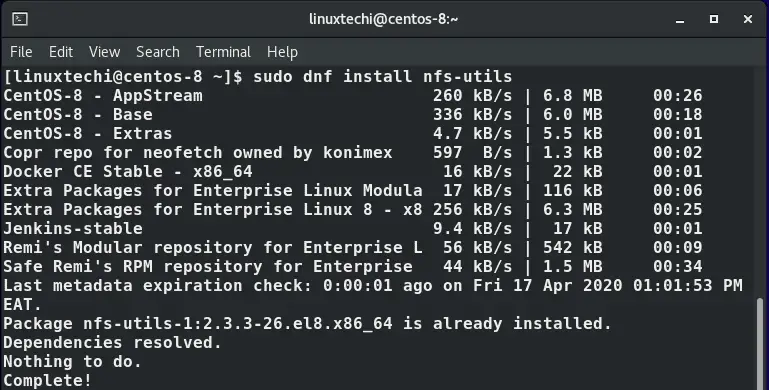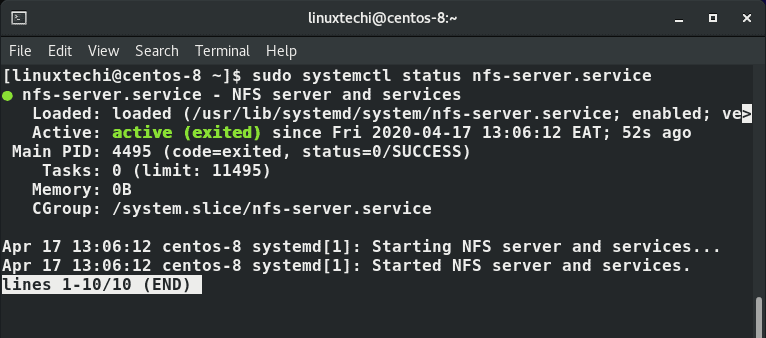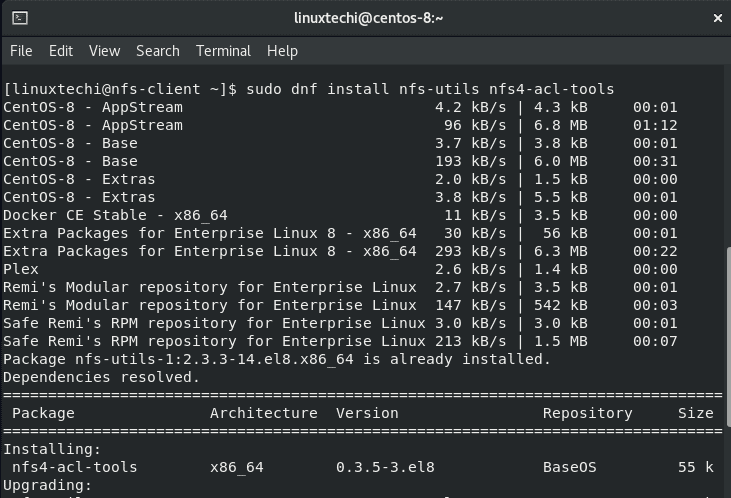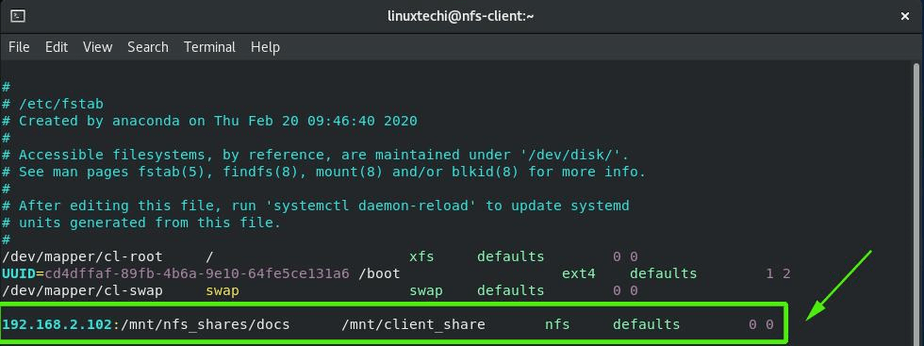- How to Setup NFS Server on CentOS 8 / RHEL 8
- NFS Server/Client setup
- Step 1) Install and Configure NFS on the CentOS 8 / RHEL 8 server
- Step 2) Creating and exporting NFS share
- Step 3) Configuring the firewall rules for NFS Server
- Setting up the NFS Client system
- Step 1) Install the required NFS packages
- Step 2) Mounting the remote NFS share located on the server
- Testing NFS Server & Client Setup
- Вики IT-KB
- Установка и настройка сервера и клиента NFS в CentOS Linux 7.2
- Установка и настройка NFS-сервера
- Установка и настройка клиента NFS
- Обсуждение
How to Setup NFS Server on CentOS 8 / RHEL 8
An acronym for Network File Share, NFS is a cross-platform client/server protocol that allows clients machines to access files shared by the NFS server over a network. Client systems can locally mount the filesystems from the NFS server and access files and directories as though they were locally mounted. In this guide, we will walk you through the installation and configuration of NFS Server on CentOS 8 / RHEL 8.
Note: In CentOS 8 or RHEL 8 NFSv3 & v4 both are supported. NFSv3 allows safe asynchronous write and supports 64-bit file sizes & offset. Whereas NFSv4 works through OS firewall and support ACL (Access Control List) and doesn’t require rpcbind service
NFS Server/Client setup
Before we get started, we are going to use the setup below to simulate how the NFS protocol works in a client/server setup.
- Server machine IP: address: 192.168.2.102 CentOS 8
- Client machine IP: address: 192.168.2.103 CentOS 8
With our setup at hand, let’s begin the installation of NFS on the server machine.
Step 1) Install and Configure NFS on the CentOS 8 / RHEL 8 server
To begin, we will install the NFS server package called nfs-utils which acts as the NFS daemon. To install the nfs-utils package, launch the terminal and run the command:
$ sudo dnf install nfs-utils -y
In the example below, nfs-utils is already installed.
Once the installation is complete, start and enable the nfs-server service so it will be automatically across the reboots. Run the following commands,
$ sudo systemctl start nfs-server.service $ sudo systemctl enable nfs-server.service
To confirm that NFS service is running, execute:
$ sudo systemctl status nfs-server.service
You can verify the version of nfs protocol that you are running by executing the command:
The version is indicated by the second column in the output presented below.
For additional configuration of the NFS server, you can find the configuration files at /etc/nfs.conf which is the NFS daemon config file and the /etc/nfsmount.conf which is the configuration file for the NFS mount.
Step 2) Creating and exporting NFS share
In this step, we are going to create a file system that will be shared from the server to client systems. In this guide, we will create a directory at /mnt/nfs_share/docs as shown below
$ sudo mkdir -p /mnt/nfs_shares/docs
To avoid file restrictions on the NFS share directory, it’s advisable to configure directory ownership as shown. This allows creation of files from the client systems without encountering any permission issues.
$ sudo chown -R nobody: /mnt/nfs_shares/docs
Also, you can decide to adjust the directory permissions according to your preference. For instance, in this guide, we will assign all the permissions (read , write and execute) to the NFS share folder
$ sudo chmod -R 777 /mnt/nfs_shares/docs
For the changes to come into effect, restart the NFS daemon:
$ sudo systemctl restart nfs-utils.service
To export the NFS share so that client systems can access it, we need to edit the /etc/exports file. You can allow multiple clients access to the share by specifying a subnet as shown
Also, you can specify each client on a separate line:
Using our setup, we will grant access to our client machine with an IP 192.168.2.103. Add the following line in the file ‘/etc/exports’:
$ sudo vi /etc/exports /mnt/nfs_shares/docs 192.168.2.103(rw,sync,no_all_squash,root_squash)
Save and exit the file. Use the cat command to confirm the entry as shown
[[email protected]] cat /etc/exports /mnt/nfs_shares/docs 192.168.2.103(rw,sync,no_all_squash,root_squash) [[email protected]]
Let’s look at the meaning of the parameters used:
- rw – This stands for read/write. It grants read and write permissions to the NFS share.
- sync – The parameter requires the writing of the changes on the disk first before any other operation can be carried out.
- no_all_squash – This will map all the UIDs & GIDs from the client requests to identical UIDS and GIDs residing on the NFS server.
- root_squash – The attribute maps requests from the root user on the client-side to an anonymous UID / GID.
To export the above created folder, use the exportfs command as shown:
The -a option implies that all the directories will be exported, -r stands for re-exporting all directories and finally -v flag displays verbose output.
Just to be dead-sure about the export list, you can display the export list using the command:
Perfect! Our export list exists. So far so good. The only configuration left on the NFS server is allowing NFS services on the firewall.
Step 3) Configuring the firewall rules for NFS Server
The final step in configuring the server is allowing NFS services through the firewall on the CentOS 8 server machine. These services are nfs, rpc-bind, and mountd. So, execute the commands below.
$ sudo firewall-cmd --permanent --add-service=nfs $ sudo firewall-cmd --permanent --add-service=rpc-bind $ sudo firewall-cmd --permanent --add-service=mountd
Then reload the firewall for the changes to come into effect
Now let’s head out to the client system and set it up to access the NFS shares.
Setting up the NFS Client system
To configure the client system to access the NFS file shares, follow the procedure below
Step 1) Install the required NFS packages
On the CentOS 8 client system, install the requisite packages for accessing the NFS share residing on the NFS server
$ sudo dnf install nfs-utils nfs4-acl-tools -y
For Debian or Ubuntu System:
$ sudo apt install nfs-common nfs4-acl-tools -y
To display the mounted NFS shares on the server, use the showmount command:
Step 2) Mounting the remote NFS share located on the server
Next, we need to mount the remote NFS share directory sitting on the local client system. But first, let’s create a directory to mount the NFS share.
$ sudo mkdir p /mnt/client_share
To mount the NFS share, execute the command below. Recall that 192.168.2.102 is the IP address of the NFS server.
$ sudo mount -t nfs 192.168.2.102:/mnt/nfs_shares/docs /mnt/client_share
You can verify the remote NFS share has been mounted by executing:
To make the mount share persistent upon a reboot, you need to edit the /etc/fstab file and append the entry below.
192.168.2.102:/mnt/nfs_shares/docs /mnt/client_share nfs defaults 0 0
Testing NFS Server & Client Setup
At this point, we are done with all the configurations. However, we need to test our setup and ensure everything works. So, first, we are going to create a test file in the NFS server share directory and check whether it is present at the client’s NFS mounted directory.
$ sudo touch /mnt/nfs_shares/docs/server_nfs_file.txt
Now, head out to the client system and check whether the file exists on the client side.
Great! From the output, we can clearly see that the file exists. Let’s now do the opposite. We are going to create a file on the NFS client system and verify whether it can be accessed from the NFS server.
On the client create the file as shown:
$ sudo touch /mnt/client_share/client_nfs_file.txt
Now, head back to the server and check whether the file is present at the NFS share directory
Awesome! We can view and access the file.
As you can see, you can easily create files on both the NFS server and client and share them seamlessly between the two systems as well as other client systems that have been configured to access the shares. And this brings us to the end of our tutorial today. In this guide, we showed you how to install and setup the NFS server and client system setup on CentOS 8 and RHEL 8.
Вики IT-KB
Установка и настройка сервера и клиента NFS в CentOS Linux 7.2
В этой статье мы рассмотрим простой пример того, как установить и настроить Network File System (NFS) в CentOS Linux 7.2. На стороне сервера будет настроена NFS-шара, а на стороне клиента эта шара будет подключена.
В некоторых дистрибутивах Linux NFS-сервер и клиент устанавливаются при установке ОС. Например в CentOS 6 NFS-сервер устанавливался по умолчанию, но служба не была включена в автозагрузку. В CentOS 7 серверные и клиентские компоненты NFS нужно устанавливать самостоятельно. При этом в CentOS 7 используется обновлённая усовершенствованная версия NFS 4.1.
Установка и настройка NFS-сервера
Устанавливаем пакеты для организации NFS-сервера
Включаем автозагрузку для служб rpcbind и nfs-server:
# systemctl enable rpcbind nfs-server Created symlink from /etc/systemd/system/multi-user.target.wants/nfs-server.service to /usr/lib/systemd/system/nfs-server.service.
# systemctl start rpcbind nfs-server
Проверяем для каких версий NFS способен принимать подключения наш NFS-сервер:
# rpcinfo -p localhost program vers proto port service . 100003 3 tcp 2049 nfs 100003 4 tcp 2049 nfs 100003 3 udp 2049 nfs 100003 4 udp 2049 nfs .
Как видим, наш NFS сервер должен принимать подключения как NFSv3 так и NFSv4.
Создаём каталог под NFS-шару
# mkdir -p /var/nfs # chmod -R 777 /var/nfs
Создаём NFS-шару в файле /etc/exports:
# cat /etc/exports /var/nfs 10.1.1.0/24(rw,sync,no_root_squash,no_all_squash)
Описание использованных опций позаиствовано отсюда:
rw – доступ на чтение и запись (может принимать значение ro-только чтение);
sync – синхронный режим доступа(может принимать обратное значение- async). sync (async) — указывает, что сервер должен отвечать на запросы только после записи на диск изменений, выполненных этими запросами. Опция async указывает серверу не ждать записи информации на диск, что повышает производительность, но понижает надежность, т.к. в случае обрыва соединения или отказа оборудования возможна потеря данных;
no_root_squash – запрет подмены uid/gid для суперпользователя (root). По умолчанию пользователь root на клиентской машине не будет иметь доступа к разделяемой директории сервера. Этой опцией мы снимаем это ограничение. В целях безопасности этого лучше не делать;
all_squash / no_all_squash — установка подмены идентификатора от всех пользователей all_squash — подмена запросов от ВСЕХ пользователей (не только root) на анонимного uid/gid, либо на пользователя, заданного в параметре anonuid/anongid. Используется обычно для публичного экспорта директорий. no_all_squash — запрет подмены uid/gid для от всех пользователей
Чтобы служба nfs-server перечитала конфигурацию, выполним
Выполнив команду exportfs убедимся в том, что ресурс опубликован:
Добавляем разрешающие правила брандмауэра:
# firewall-cmd --permanent --zone=public --add-service=nfs # firewall-cmd --permanent --zone=public --add-service=mountd # firewall-cmd --permanent --zone=public --add-service=rpc-bind # firewall-cmd --reload
Установка и настройка клиента NFS
Устанавливаем пакетов поддержки NFS:
Включаем и запускаем включаем службы NFS:
# systemctl start rpcbind # systemctl enable rpcbind
Создаем каталог, в который будет смонтирована шара и монтируем шару:
# mkdir /mnt/nfs-share # mount -t nfs KOM-FS03.holding.com:/var/nfs/ /mnt/nfs-share/
Проверяем то, что каталог примонтирован:
# mount | grep nfs4 KOM-FS03.holding.com:/var/nfs/ on /mnt/nfs-share type nfs4 (rw,relatime,vers=4.0,rsize=1048576,wsize=1048576, namlen=255,hard,proto=tcp,port=0,timeo=600,retrans=2,sec=sys, clientaddr=10.1.1.201,local_lock=none,addr=10.1.1.4)
# df -hT | grep nfs4 KOM-FS03.holding.com:/var/nfs nfs4 3.6T 88M 3.4T 1% /mnt/nfs-share
Проверим возможность записи в шару
# touch /mnt/nfs-share/test.txt # rm /mnt/nfs-share/test.txt
Настраиваем автоматическое монтирование шары при перезагрузке системы, добавляя запись в конец файла /etc/fstab:
# cat /etc/fstab . KOM-FS03.holding.com:/var/nfs/ /mnt/nfs-share/ nfs defaults 0 0
Автор первичной редакции:
Алексей Максимов
Время публикации: 01.09.2016 15:30
Обсуждение
unix-linux/centos/linux-how-to-setup-nfs-server-with-share-and-nfs-client-in-centos-7-2.txt · Последнее изменение: 02.09.2016 15:33 — Алексей Максимов


















